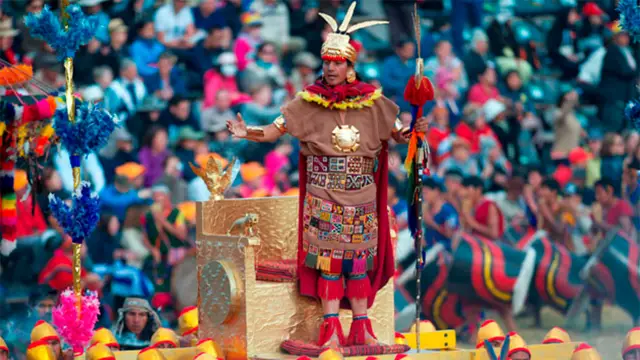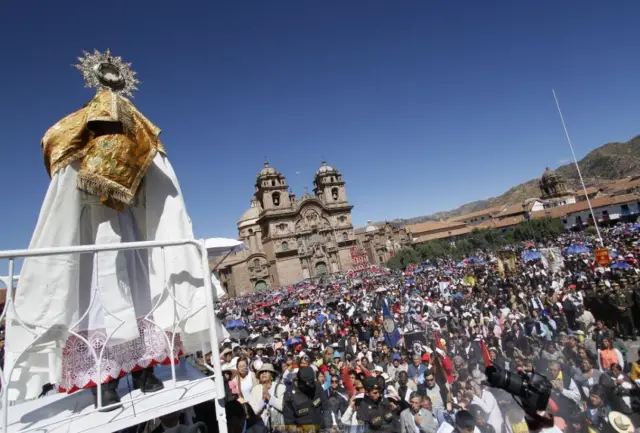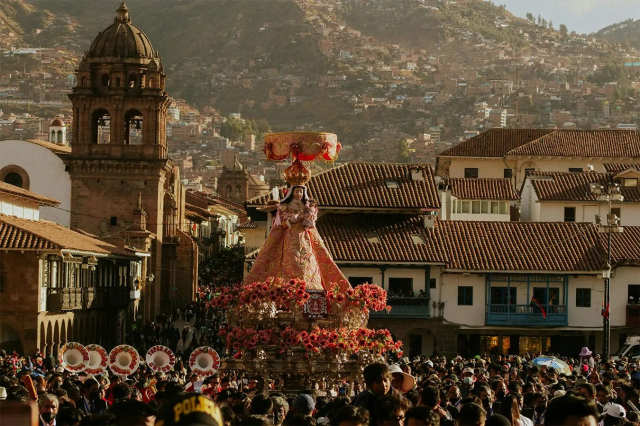Corpus Christi in Cusco is one of the most emblematic religious festivals of the Catholic liturgical calendar in Peru. This celebration, which takes place in the imperial city of Cusco, represents an exceptional fusion between the Christian spirituality brought by the Spanish and the ancestral beliefs of Andean cultures. With a history dating back to the 16th century, Corpus Christi has not only endured over time but has also evolved, becoming a vibrant expression of identity and faith that brings together thousands of people each year, both locals and visitors from around the world.
During this celebration, the streets of the historic center are transformed into a colorful and lively setting, where 15 religious images of saints and virgins—each representing a different parish in Cusco—are carried in a solemn procession to the Cusco Cathedral . This act of devotion is accompanied by traditional music bands, dancers dressed in traditional costumes, and hundreds of parishioners who accompany their saints with songs, prayers, and expressions of faith. The atmosphere is imbued with a profound mysticism, but also with a popular joy that makes Corpus Christi an unforgettable experience for anyone who witnesses it.
History and origin of Corpus Christi in Cusco
Fusion of beliefs: religious syncretism
The history of Corpus Christi in Cusco is closely linked to the evangelization process that took place after the conquest of the Inca Empire. When the Spanish introduced Christianity to South America, they found in the Andean civilizations a religiosity deeply rooted in nature, the stars, and tutelary gods such as Inti (the sun) and Pachamama (Mother Earth). To facilitate the conversion of the indigenous peoples, a religious syncretism was allowed, adapting many local traditions to the Christian calendar.
In this context, Corpus Christi became a strategic date, as its proximity to Inti Raymi , the ancient Inca sun festival, allowed for symbolic parallels to be drawn between Catholic saints and pre-Hispanic deities. Thus, images of saints and virgins began to be venerated with the same fervor as the Andean gods, incorporating ritual elements such as music, dance, and the use of ceremonial attire. This spiritual duality remains visible today, making Corpus Christi a clear example of the cultural fusion that defines Peru.

How is Corpus Christi celebrated?
Central day: Corpus Christi Thursday
Corpus Christi Thursday is the culminating moment of the celebration. From dawn, the neighborhoods and parishes of Cusco prepare to carry their saints to the Plaza Mayor. The images, many of them centuries old and wearing richly embroidered vestments, are mounted on floats adorned with flowers and symbolic elements and carried on the shoulders of the carguyoq (devotees in charge of their transport). This act represents not only an act of faith, but also a sign of community commitment and neighborhood pride.
Along the route to the Cathedral, the streets come alive with the presence of traditional musicians performing huaynos, folk dances, symphonic bands, and groups of dancers in traditional costumes that express the cultural diversity of the region. Entire families accompany their images, pray, sing, and share traditional foods. The arrival at the Cathedral is an emotional moment that reflects the spiritual unity of an entire people, and for a week, the images remain in the temple as a sign of religious brotherhood.
The Octave: Farewell and Return of the Saints
The octave of Corpus Christi , which takes place one week after the main day, marks the close of the festival. During this day, the images return to their parishes in another procession full of symbolism. This moment is experienced with great intensity, as it is considered a blessing to accompany the saints on their return. Once again, the streets are filled with music, dance, and popular fervor, and the community bonds that make Corpus Christi a unique festival in the country are strengthened.
Highlights of the festivity
Sacred images
One of the most impressive aspects of Corpus Christi in Cusco is the devotion to the religious images, each with its own history, characteristics, and brotherhoods that care for them throughout the year. These images, such as Saint Anthony the Abbot , Saint Sebastian , Saint Anne , and Saint Blaise , are carried with great respect and solemnity by their parishioners, who proudly assume the responsibility of organizing every detail of their participation in the procession. The thrones on which the images travel can weigh up to a ton, requiring dozens of porters who take turns transporting them.
Typical gastronomy
The celebration is also a feast for the palate. Chiri uchu is the typical dish of Corpus Christi and is widely consumed during these days. This cold dish includes ingredients representative of Peru's diverse regions: chactado guinea pig (from the mountains), fresh cheese, flour tortillas, dried seaweed (from the Andes), chicken, sausages, and corn. More than a meal, it is an expression of the country's biodiversity and the cultural integration of its peoples. During the festivities, it is common to see entire families gathered in the Plaza Mayor or in the surrounding streets sharing this traditional delicacy.

Cultural and tourist importance
Corpus Christi is not only a religious event for the people of Cusco, but also an event of great cultural and tourist value. Every year, thousands of national and international travelers come to Cusco to experience this unique manifestation of popular religiosity firsthand. In addition to the spiritual experience, visitors have the opportunity to appreciate firsthand the richness of sacred art, traditional music, and community organization that make this celebration possible.
The festival has been declared a National Cultural Heritage Site and is part of Peru's official calendar of tourist events. Municipal authorities, in collaboration with communities and parishes, work hard to preserve its authenticity and ensure a safe and respectful experience for all attendees.
Recommendations for celebrating Corpus Christi in Cusco
Key Dates: The celebration takes place 60 days after Easter Sunday, usually in June. It's a good idea to check the liturgical calendar before planning your trip.
Ideal location: Cusco's Plaza Mayor and its surroundings are the focal point of the festival, where processions, meals, and cultural activities are concentrated.
Clothing: Due to the cold and dry weather in Cusco in June, it is recommended to wear warm clothing, comfortable shoes, and sun protection during the day.
Behavior: Showing respect for local religious and cultural expressions is essential. Avoid invading procession spaces and follow the organizers' instructions.

Frequently asked questions about Corpus Christi in Cusco
When is Corpus Christi celebrated in Cusco?
It is celebrated 60 days after Easter Sunday, which usually occurs in June, although the exact date varies each year according to the liturgical calendar.
Which saints participate in the procession?
Fifteen saints and virgins from different Cusco parishes participate, including Saint Sebastian, Saint Anne, Saint Blaise, Saint Joseph, and the Virgin of Los Remedios, each with their own retinue of faithful and musicians.
What is chiri uchu?
It is a typical Corpus Christi dish in Cusco, consisting of guinea pig, chicken, sausages, seaweed, cheese, corn flour tortilla and other ingredients served cold.
What is the cultural significance of Corpus Christi?
It represents the fusion of European Christianity and Andean traditions, and is a living example of the cultural syncretism that characterizes Peru.
Can you attend as a tourist?
Yes, the festival is open to the public, and tourists are encouraged to participate respectfully. It's an excellent opportunity to learn about popular religiosity and the cultural identity of Cusco.
A celebration that unites faith, culture and tradition
Corpus Christi in Cusco is one of those experiences that leaves a lasting impression on those who experience it. It's not just a religious festival, but a cultural event that conveys centuries of history, syncretism, and popular fervor. The majestic processions, the symbolism of each image, the traditional flavors of chiri uchu, and the warmth of its people make this celebration an authentic and unforgettable experience. If you're looking to experience the soul of Cusco, there's no better time than now to connect with its spirituality and traditions. Make time in your schedule and experience Corpus Christi like never before!
